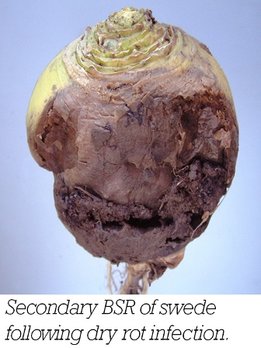Bacterial soft rot (BSR)
BSR causes damage as a secondary invader following infection by other pathogens (e.g. dry rot) or through tissue damaged by insects or weather. It is caused by the bacterium Erwinia carotovora.
Identification
BSR produces a soft, watery light brown-grey rot often with an unpleasant odour. Although similar to Sclerotinia infection, no white mycelium are associated with the damage and no sclerotia are produced.

Importance
Under conducive conditions, BSR can cause considerable additional damage to the original infection or damaging agent.
Spread
BSR is mostly soil-borne and enters the host through rain splash from wet soil onto damaged areas. It then spreads by direct plant contact, animal/machinery movement and by insects.
Prevention and management
BSR can be greatly reduced by minimising plant damage and the carry over of host debris. Good crop rotation and cultivation practices are essential to limit the damage caused by this disease.

